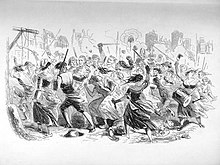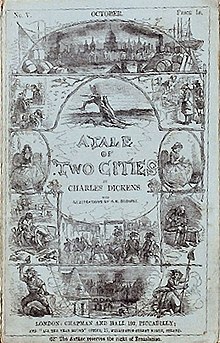A story from two cities
A Tale of Two Cities (AKA: A Tale of Two Cities ) is a historical novel by Charles Dickens in 1859. He is one of the most famous works of world literature .
Emergence
Dickens wrote this novel in 1859 when his own life was changing dramatically. He divorced, his UK weekly Household Words died , while he started a new All the Year Round magazine .
"It was the best of times, it was the worst of times, it was the age of wisdom, it was the age of foolishness ..." is how his novel about the life of Dr. Manette and his daughter Lucie in two cities, London and Paris . A gloomy opening scene playing in the fog of London, a trip to Paris to find out about the innocent trapped in the Bastille for many years . Bringing Manette back to London, his daughter Lucie's love story for Charles Darnay, a London-based Marquis de Evremonde , and the dramatic links with the Parisian capital during the reign of terror of the la guillotine are the content of this novel, with an eternally drunk protagonist, Sydney Carton , becomes the tragic hero of this story from a supporting role.
The idea for the story came from Charles Dickens, as he himself wrote in the foreword to the 1859 edition, while participating in the theater drama The Frozen Deep by Wilkie Collins , which he staged with his children and friends. With the help of the impressions of his stay in Paris in the winter of 1855 and based on the reports of the Scotsman Thomas Carlyle about the French Revolution, he wrote a book full of sadness, but also full of enthusiasm.
content



The novel is set in Paris and London . The life story of Dr. Manette, his daughter Lucie and her husband Charles Darnay in the turmoil of the French Revolution . When Charles is sentenced to death by the revolutionaries, the young lawyer Sydney Carton, who is in love with Lucie, saves his life: Instead of Lucie's husband, Sydney climbs the scaffold and dies for him.
media
literature
- Current book editions
- A Tale of Two Cities . Penguin Classics, London 2003, ISBN 0-14-143960-2
- Two cities . Leipzig 1860 (from L. Wiedemann. First German edition as translated by Julius Seybt ,? -1871)
- A story from two cities . Insel Taschenbuch (it 1033), Frankfurt am Main 1987, ISBN 3-458-32733-9
Film adaptations
The book has been made into a film many times. The best-known film adaptation by Jack Conway dates from 1935 and bears the German title Escape from Paris . Ralph Thomas filmed the material in 1958. In Germany, the film was released under the title Zwei Cities .
Trivia
Margaret Thatcher presented François Mitterrand in 1989, on the occasion of the 200th anniversary of the French Revolution, with a valuable first edition of Dickens' story from two cities - with the remark that the unnecessary nature of the revolution can be read there.
The book is an insider gag in the Star Trek franchise. It first appears in Star Trek II: The Wrath of Khan . James Kirk receives the book as a gift from Spock, opens the first page and quotes the first sentence ("It was the best time, it was the worst time"). At the end of the film, Kirk quotes the last sentence to say goodbye to Spock ("Everything is much, much better than what I've done in my whole life; a far better last place than I've ever seen one.").
Towards the end of Star Trek: Deep Space Nine , the book will be shown again. Dr. Bashir opens the book and reads the first sentence on page 294 (“It was the best time, it was the worst time”), realizing that something is wrong.
Individual evidence
- ↑ Margaret Thatcher: 10, Downing Street: Mémoires Albin Michel. 1993. ISBN 2-2260-6590-3 . P. 1040 f. (English)
- ↑ Star Trek II: The Wrath of Khan
- ↑ Star Trek: Deep Space Nine Season 7, Episode 23 Extreme Measures

